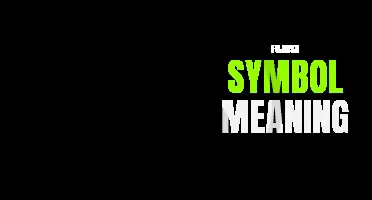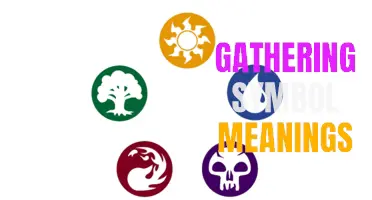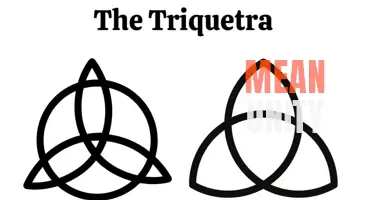
Throughout history, symbols have played a significant role in various cultures and societies. One such culture that is known for its mysticism and spirituality is the Celts. The ancient Celts used symbols as a way to communicate their beliefs, values, and traditions. These symbolic representations showcased their connection with nature, gods, and the cycles of life. From the interconnected knots of the Celtic knots to the powerful Triskelion, each symbol holds a deeper meaning that provides insight into the Celtic culture. Join me as we explore the enchanting world of Celtic symbols and unlock the secrets hidden within.
What You'll Learn
- What are some common Celtic symbols and what do they mean?
- How do Celtic symbols differ from symbols used in other cultures?
- Are there any specific colors or shapes associated with Celtic symbols?
- Do Celtic symbols have any religious or spiritual significance?
- Are there any hidden or secret meanings behind certain Celtic symbols?

What are some common Celtic symbols and what do they mean?
Celtic culture has a rich tradition of symbols that are deeply rooted in their mythology and beliefs. These symbols have been passed down through generations and continue to hold significant meaning today. Here are some of the most common Celtic symbols and what they represent.
- Celtic Knot: Perhaps the most famous Celtic symbol is the Celtic knot. It is a continuous and unending design that loops and interweaves with no beginning or end. This symbolizes the eternal cycle of life and death, as well as the interconnectedness of all things. Different types of Celtic knots have different meanings. For example, the Trinity Knot represents the Holy Trinity in Christianity, while the love knot symbolizes everlasting love and unity.
- Triquetra: The Triquetra symbol is a three-pointed knot that represents the concept of threes in Celtic culture, such as the three realms of earth, sea, and sky, or the three stages of life: birth, death, and rebirth. It is also associated with the Holy Trinity in Christianity. The interwoven lines of the Triquetra symbolize the weaving together of these different aspects.
- Celtic Cross: The Celtic Cross is a cross with a circle intersecting the vertical and horizontal lines. It combines the Christian cross with Celtic symbolism. The cross represents Christ's sacrifice, while the circle represents eternity and the ancient sun worship of the Celts. It is believed to bring protection and blessings.
- Spiral: The spiral is a common Celtic symbol that represents growth, transformation, and journey. It is believed to symbolize the journey of life and the continuous cycle of death and rebirth. The spiral can be found in various Celtic artifacts, such as stone carvings and jewelry.
- Claddagh: The Claddagh is a traditional Irish symbol that represents love, loyalty, and friendship. It features a heart being held by two hands, with a crown on top. The heart represents love, the hands represent friendship, and the crown represents loyalty. The Claddagh is often used in jewelry, especially as a symbol of Irish heritage.
- Tree of Life: The Tree of Life symbolizes the connection between heaven and earth, as well as the interconnectedness of all living things. It is believed to represent wisdom, strength, and renewal. The tree's branches reach high into the sky, while its roots dig deep into the earth, creating a strong foundation.
- Dara Knot: The Dara Knot is a Celtic symbol that represents strength, wisdom, and endurance. It takes the shape of a knot with four corners, symbolizing the four pillars of strength: mental, physical, emotional, and spiritual. The Dara Knot is often associated with oak trees, which were considered sacred by the ancient Celts.
These are just a few examples of the many Celtic symbols that exist. Each symbol carries its own unique meaning and significance, making them cherished and respected symbols of Celtic heritage. They serve as a reminder of the deep spiritual beliefs and traditions that are still celebrated by Celtic communities today.
Decoding the Symbols and Meanings of Hanukkah: The Festival of Lights
You may want to see also

How do Celtic symbols differ from symbols used in other cultures?
Celtic symbols hold a deep and meaningful significance within the Celtic culture. These symbols have been used for centuries to convey powerful messages, beliefs, and historical events. However, the Celtic symbols differ from symbols used in other cultures in various ways. Let's explore and understand these differences.
One prominent characteristic of Celtic symbols is their intricacy and knot-like patterns. Unlike many symbols used in other cultures, Celtic symbols often consist of interwoven knots that have no beginning or end. These knot patterns are believed to symbolize the eternal cycle of life, the interconnectedness of all things, and the infinite nature of the universe. In contrast, symbols from other cultures may have more straightforward designs or represent specific objects or ideas.
Another distinction between Celtic symbols and symbols from other cultures is their connection to nature and spirituality. Celtic culture places great importance on the natural world and its elements such as trees, animals, and rivers. As a result, many Celtic symbols incorporate these natural elements as a way of honoring and seeking harmony with nature. In contrast, symbols from other cultures may have different spiritual or religious connotations that may not necessarily revolve around nature.
Furthermore, Celtic symbols often carry a rich historical significance. Many of these symbols have deep cultural roots and can be traced back to ancient Celtic clans, tribes, or mythological stories. These symbols are used to commemorate significant events, express ancestral pride, or serve as a form of protection. Symbols in other cultures, on the other hand, may have diverse origins and meanings, ranging from religious beliefs to personal expressions of identity.
It is also worth noting that Celtic symbols have gained popularity and recognition worldwide. People from different cultures and backgrounds are drawn to these symbols for their aesthetic appeal, deep symbolism, and spiritual resonance. Many individuals choose to incorporate Celtic symbols into tattoos, artwork, jewelry, or even home decor as a way of connecting with their Celtic heritage or embracing the values associated with these symbols.
In conclusion, Celtic symbols differ from symbols used in other cultures in terms of their intricate knot designs, their connection to nature and spirituality, their historical significance, and their global recognition. These symbols are a unique and cherished part of Celtic culture, carrying with them a rich legacy that continues to inspire and captivate people from all corners of the world.
The Freemason Symbol: Decoding the Meaning Behind the 'G
You may want to see also

Are there any specific colors or shapes associated with Celtic symbols?
Celtic symbols have a long history and are known for their intricate and meaningful designs. While there are no specific colors or shapes that are universally associated with Celtic symbols, there are certain color palettes and shapes that are commonly used.
In terms of colors, Celtic symbols often incorporate earthy tones such as greens, browns, and grays. These colors are reminiscent of the natural landscapes of Celtic regions, such as Ireland and Scotland. These earthy tones not only represent the connection to nature but also symbolize the Celtic belief in the interconnectedness of all living things.
In addition to earthy tones, Celtic symbols also frequently use vibrant colors such as red, blue, and yellow. These bright colors are often used to add emphasis and energy to the designs. They can represent various elements such as fire, water, and light, which held significance in Celtic mythology.
When it comes to shapes, Celtic symbols are known for their interwoven patterns and knots. These intricate interlacings symbolize the endless cycles of life, death, and rebirth. The most commonly seen shape in Celtic symbols is the triquetra, also known as the Trinity Knot. This knot consists of three interconnected loops, which represent the Holy Trinity, as well as the interconnectedness of mind, body, and spirit.
Other shapes frequently used in Celtic symbols include spirals, spirals, and meanders. Spirals represent the journey of life and the cyclical nature of the universe. They are also associated with spiritual growth and enlightenment. Meanders, on the other hand, represent the interconnectedness of all things and the continuous flow of energy.
In conclusion, while there are no specific colors or shapes that are universally associated with Celtic symbols, they often incorporate earthy tones and vibrant colors. Additionally, the interwoven patterns and knots, such as the triquetra, spirals, and meanders, are commonly seen in Celtic designs. These symbols hold deep meaning and represent the Celtic beliefs in nature, interconnectedness, and the cycles of life and rebirth.
Uncovering the Symbolic Meaning of the Sun and Moon
You may want to see also

Do Celtic symbols have any religious or spiritual significance?
Celtic symbols are an integral part of Celtic culture and history. They have been used for centuries by the Celtic people to represent various aspects of their lives, including their religious and spiritual beliefs. These symbols hold great significance and are still widely recognized and used today.
One of the most well-known Celtic symbols is the Celtic cross. This symbol combines the traditional Christian cross with a circle, which is believed to represent the eternal and infinite nature of God's love. The Celtic cross is often seen in Celtic art and jewelry and is associated with Christianity and Celtic spirituality.
Another important Celtic symbol is the triskelion. This symbol features three interlocking spirals and is believed to represent three important aspects of the Celtic belief system: the realms of land, sea, and sky; the three stages of life (birth, death, and rebirth); and the Celtic concept of the trinity. The triskelion is often used as a protective symbol and can be found on ancient Celtic artifacts and monuments.
The triquetra is another symbol with religious and spiritual significance in Celtic culture. It consists of three interlocking loops and is associated with the concept of the trinity, as well as the interconnectedness of the mind, body, and spirit. The triquetra is often used as a symbol of protection and is commonly found in Celtic art, jewelry, and tattoos.
The Celtic knot is a symbol that represents the eternal nature of life and the interwoven connections of all things. These knots are often used in Celtic art and were commonly found in ancient Celtic manuscripts. The intricate designs symbolize the interconnectedness of all living beings and the cyclical nature of life and death.
In addition to these specific symbols, many other Celtic designs and patterns hold religious and spiritual significance. Celtic art often features intricate patterns and knots that symbolize eternity, balance, and harmony. These symbols were not only decorative but also served as a way to convey important spiritual and religious concepts.
Today, many people still use Celtic symbols for their religious and spiritual practices. These symbols are often incorporated into meditation, rituals, and ceremonies to connect with ancient Celtic beliefs and traditions. Many individuals also wear Celtic jewelry or get Celtic tattoos to honor their Celtic heritage and express their spiritual beliefs.
In conclusion, Celtic symbols have a significant religious and spiritual significance. These symbols represent important concepts such as the interconnectedness of all things, the eternal nature of life, and the trinity. They are still widely recognized and used today in Celtic culture and hold deep meaning for those who embrace their Celtic heritage and spirituality.
The Meaning Behind Symbols on Plastic Containers Explained
You may want to see also

Are there any hidden or secret meanings behind certain Celtic symbols?
The Celtic culture is rich in symbolism, and their symbols have deep meanings that go beyond their aesthetic appeal. Many of these symbols have been passed down through generations and hold a significant place in Celtic mythology and folklore. While some symbols are well-known and easily recognized, others have hidden or secret meanings that only a few may be aware of. In this article, we will explore some of these hidden meanings behind certain Celtic symbols.
- Triquetra: The triquetra is a Celtic symbol that consists of three interlocking loops. It is often associated with the concept of trinity, representing various triads such as past, present, and future or mind, body, and spirit. However, there is a hidden meaning behind this symbol related to the cycles of life. The three loops of the triquetra can also represent birth, life, and death, symbolizing the eternal nature of existence.
- Claddagh: The claddagh is a heart-shaped symbol with a crown on top and two hands holding the heart. It is commonly associated with love, friendship, and loyalty. However, there is another layer of meaning to the claddagh symbol. Depending on how it is worn, it can indicate the relationship status of the person wearing it. When worn on the right hand with the heart facing outward, it signifies that the person is single. When worn on the right hand with the heart facing inward, it represents that the person is in a relationship. And when worn on the left hand with the heart facing inward, it signifies that the person is married.
- Celtic Knots: Celtic knots are intricate designs that are known for their endless loops and interwoven patterns. They are often used to represent the eternal nature of life and the interconnectedness of all things. However, some Celtic knots have hidden meanings specific to their design. For example, the Celtic love knot, also known as the mystic knot, is a knot that has no beginning or end. It symbolizes eternal love, unity, and the interplay of the physical and spiritual realms.
- Tree of Life: The Tree of Life is a symbol that represents the interconnectedness of all living things and the cycle of life, death, and rebirth. However, the Tree of Life also has a hidden meaning related to ancestry and heritage. In Celtic culture, trees were believed to be the ancestors of humans, and each tree had specific qualities and attributes associated with it. The Tree of Life symbolizes the collective wisdom, strength, and knowledge of the ancestors, and serves as a reminder to honor and connect with one's roots.
- Spiral: The spiral is a common Celtic symbol that is characterized by a continuous, winding curve. It represents the journey of life, growth, and transformation. However, the spiral also has a hidden meaning related to inner and outer balance. In Celtic belief, life is a constant balancing act between the inner and outer worlds. The spiral symbolizes the need to find harmony and equilibrium between these two aspects of existence.
In conclusion, Celtic symbols are more than just beautiful designs. They have deep meanings that reflect the beliefs, values, and mythology of the Celtic culture. While some meanings are well-known and easily recognizable, others remain hidden or secret, waiting to be discovered by those who delve deeper into the mystical world of Celtic symbolism. So the next time you come across a Celtic symbol, take a moment to explore its hidden meanings and connect with the wisdom of the ancient Celts.
The Meaning Behind Kyrie Irving's Infinity Symbols
You may want to see also
Frequently asked questions
The Celtic knot is a popular symbol in Celtic culture and it holds various meanings. One common interpretation is that it represents the interconnectedness of life and eternity. The intricate weaving of the knot symbolizes the continuous cycle of birth, death, and rebirth, and the unbroken lines signify the everlasting connection between all things.
The Celtic cross is a powerful symbol that combines the Christian cross with the traditional Celtic circle. It has deep religious and cultural significance for many people. The vertical line of the cross represents the connection between Earth and Heaven, while the horizontal line represents the connection between the physical and spiritual worlds. The circle surrounding the intersection of the lines symbolizes eternity and the never-ending cycle of life and death.
The triskele, also known as the triple spiral, is a symbol with roots in Celtic mythology. It consists of three interlocking spirals that form a triangle shape. The triskele is often associated with concepts such as growth, progress, and transformation. It represents the three realms of existence in Celtic cosmology: the physical world, the spiritual world, and the celestial world. The symbol is also believed to embody the three stages of life: birth, life, and death.







